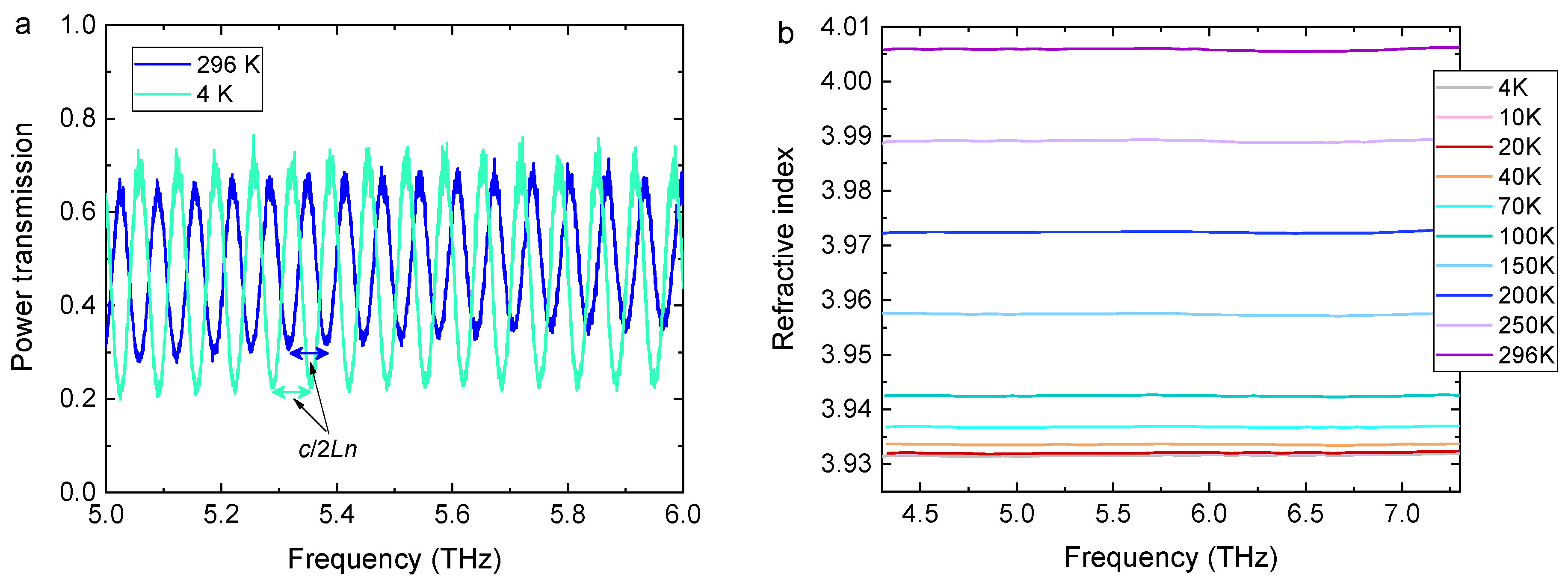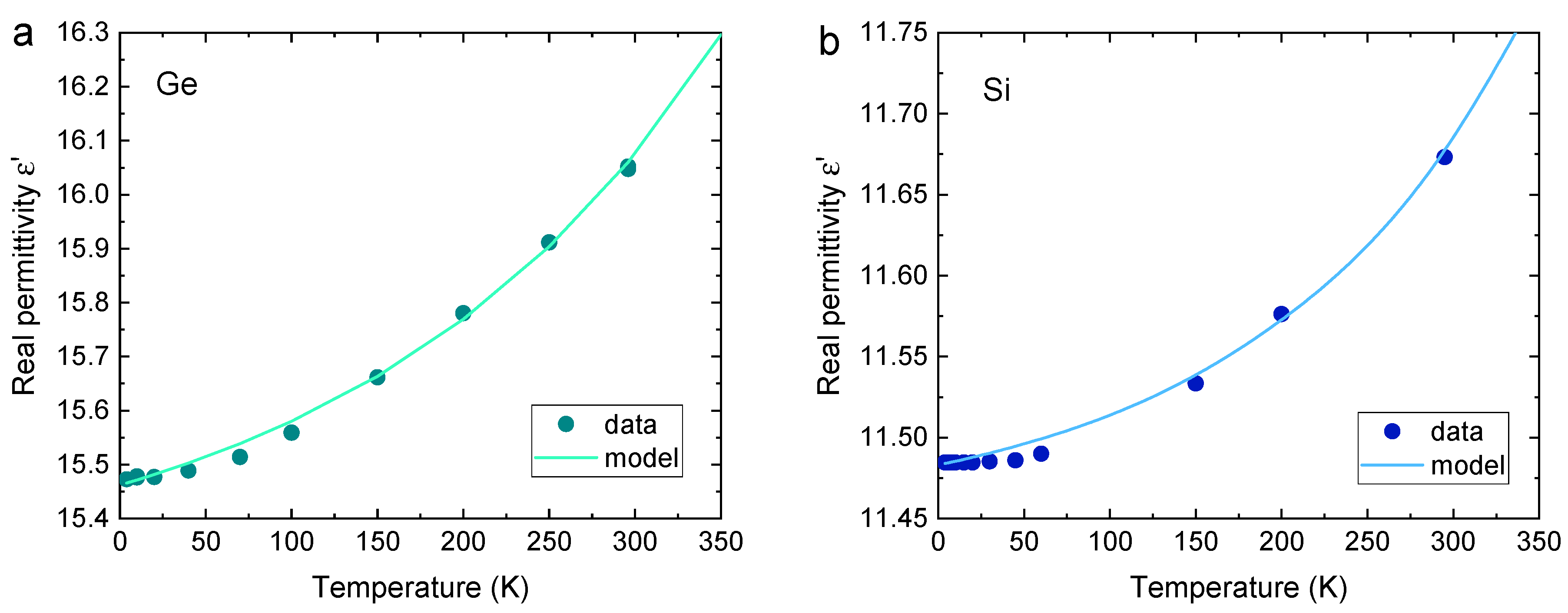Refractive Indices of Ge and Si at Temperatures between 4–296 K in the 4–8 THz Region
Abstract
:Featured Application
Abstract
1. Introduction
2. Materials and Methods
3. Results and Discussion
4. Conclusions
Author Contributions
Funding
Institutional Review Board Statement
Informed Consent Statement
Data Availability Statement
Conflicts of Interest
References
- Dhillon, S.S.; Vitiello, M.S.; Linfield, E.H.; Davies, A.G.; Hoffmann, M.C.; Booske, J.; Paoloni, C.; Gensch, M.; Weightman, P.; Williams, G.P.; et al. The 2017 terahertz science and technology roadmap. J. Phys. D Appl. Phys. 2017, 50, 043001. [Google Scholar] [CrossRef]
- Mittleman, D.M. Perspective: Terahertz science and technology. J. Appl. Phys. 2017, 122, 230901. [Google Scholar] [CrossRef]
- Jepsen, P.U.; Cooke, D.G.; Koch, M. Terahertz spectroscopy and imaging—Modern techniques and applications. Laser Photonics Rev. 2011, 5, 124–166. [Google Scholar] [CrossRef]
- Neu, J.; Schmuttenmaer, C. Tutorial: An introduction to terahertz time domain spectroscopy (THz-TDS). J. Appl. Phys. 2018, 124, 231101. [Google Scholar] [CrossRef] [Green Version]
- Hwang, H.Y.; Fleischer, S.; Brandt, N.C.; Perkins, B.G., Jr.; Liu, M.; Fan, K.; Sternbach, A.; Zhang, X.; Averitt, R.D.; Nelson, K.A. A review of non-linear terahertz spectroscopy with ultrashort tabletop-laser pulses. J. Mod. Opt. 2014, 62, 1447–1479. [Google Scholar] [CrossRef]
- Mittleman, D.M. Twenty years of terahertz imaging [Invited]. Opt. Express 2018, 26, 9417–9431. [Google Scholar] [CrossRef]
- Guerboukha, H.; Nallappan, K.; Skorobogatiy, M. Toward real-time terahertz imaging. Adv. Opt. Photonics 2018, 10, 843–938. [Google Scholar] [CrossRef]
- Nicoletti, D.; Cavalleri, A. Nonlinear light–matter interaction at terahertz frequencies. Adv. Opt. Photonics 2016, 8, 401–464. [Google Scholar] [CrossRef]
- Chick, S.; Stavrias, N.; Saeedi, K.; Redlich, B.; Greenland, P.T.; Matmon, G.; Naftaly, M.; Pidgeon, C.R.; Aeppli, G.; Murdin, B. Coherent superpositions of three states for phosphorous donors in silicon prepared using THz radiation. Nat. Commun. 2017, 8, 16038. [Google Scholar] [CrossRef] [Green Version]
- Naftaly, M.; Vieweg, N.; Deninger, A. Industrial Applications of Terahertz Sensing: State of Play. Sensors 2019, 19, 4203. [Google Scholar] [CrossRef] [Green Version]
- Kohlhaas, R.B.; Breuer, S.; Liebermeister, L.; Nellen, S.; Deumer, M.; Schell, M.; Semtsiv, M.P.; Masselink, W.T.; Globisch, B. 637 μW emitted terahertz power from photoconductive antennas based on rhodium doped InGaAs. Appl. Phys. Lett. 2020, 117, 131105. [Google Scholar] [CrossRef]
- Piccoli, R.; Rovere, A.; Jeong, Y.-G.; Jia, Y.; Zanotto, L.; Légaré, F.; Schmidt, B.E.; Morandotti, R.; Razzari, L. Extremely broadband terahertz generation via pulse compression of an Ytterbium laser amplifier. Opt. Express 2019, 27, 32659–32665. [Google Scholar] [CrossRef] [PubMed]
- Vicario, C.; Ruchert, C.; Hauri, C.P. High field broadband THz generation in organic materials. J. Mod. Opt. 2013, 62, 1480–1485. [Google Scholar] [CrossRef]
- Chick, S.; Murdin, B.N.; Matmon, G.; Naftaly, M. Metrology of complex refractive index for solids in the terahertz regime using frequency domain spectroscopy. Metrologia 2018, 55, 771–781. [Google Scholar] [CrossRef]
- Parrott, E.P.J.; Zeitler, J.A. Terahertz Time-Domain and Low-Frequency Raman Spectroscopy of Organic Materials. Appl. Spectrosc. 2015, 69, 1–25. [Google Scholar] [CrossRef]
- Supporting Data for “Metrology of Complex Refractive Index for Solids in the Terahertz Regime Using Frequency Domain Spectroscopy”. Available online: https://doi.org/10.5281/zenodo.1237819 (accessed on 5 January 2021).
- Carr, R.H.; McCammon, R.D.; White, G.K. Thermal expansion of germanium and silicon at low temperatures. Philos. Mag. 1965, 12, 157–163. [Google Scholar] [CrossRef]
- White, G.K.; Minges, M.L. Thermophysical properties of some key solids: An update. Int. J. Thermophys. 1997, 18, 1269–1327. [Google Scholar] [CrossRef]
- Loewenstein, E.V.; Smith, D.R.; Morgan, R.L. Optical Constants of Far Infrared Materials 2: Crystalline Solids. Appl. Opt. 1973, 12, 398–406. [Google Scholar] [CrossRef]
- Nelson, E.; Withers, S.; Muravjov, A.V.; Strijbos, R.; Peale, R.E.; Pavlov, S.G.; Shastin, V.N.; Fredricksen, C. High-resolution study of composite cavity effects for p-Ge lasers. IEEE J. Quantum Electron. 2001, 37, 1525–1530. [Google Scholar] [CrossRef]
- Muravjov, A.V.; Withers, S.H.; Strijbos, R.C.; Pavlov, S.G.; Shastin, V.N.; Peale, R.E. Actively mode-locked p-Ge laser in Faraday configuration. Appl. Phys. Lett. 1999, 75, 2882–2884. [Google Scholar] [CrossRef] [Green Version]
- Randall, C.M.; Rawcliffe, R.D. Refractive Indices of Germanium, Silicon, and Fused Quartz in the Far Infrared. Appl. Opt. 1967, 6, 1889–1895. [Google Scholar] [CrossRef] [PubMed]
- Dai, J.; Zhang, J.; Zhang, W.; Grischkowsky, D. Terahertz time-domain spectroscopy characterization of the far-infrared absorption and index of refraction of high-resistivity, float-zone silicon. J. Opt. Soc. Am. B 2004, 21, 1379–1386. [Google Scholar] [CrossRef] [Green Version]
- Duffy, J.A. Bonding, Energy Levels and Bands in Inorganic Solids; Longman Scientific & Technical: New York, NY, USA, 1990. [Google Scholar]


Publisher’s Note: MDPI stays neutral with regard to jurisdictional claims in published maps and institutional affiliations. |
© 2021 by the authors. Licensee MDPI, Basel, Switzerland. This article is an open access article distributed under the terms and conditions of the Creative Commons Attribution (CC BY) license (http://creativecommons.org/licenses/by/4.0/).
Share and Cite
Naftaly, M.; Chick, S.; Matmon, G.; Murdin, B. Refractive Indices of Ge and Si at Temperatures between 4–296 K in the 4–8 THz Region. Appl. Sci. 2021, 11, 487. https://doi.org/10.3390/app11020487
Naftaly M, Chick S, Matmon G, Murdin B. Refractive Indices of Ge and Si at Temperatures between 4–296 K in the 4–8 THz Region. Applied Sciences. 2021; 11(2):487. https://doi.org/10.3390/app11020487
Chicago/Turabian StyleNaftaly, Mira, Steve Chick, Guy Matmon, and Ben Murdin. 2021. "Refractive Indices of Ge and Si at Temperatures between 4–296 K in the 4–8 THz Region" Applied Sciences 11, no. 2: 487. https://doi.org/10.3390/app11020487
APA StyleNaftaly, M., Chick, S., Matmon, G., & Murdin, B. (2021). Refractive Indices of Ge and Si at Temperatures between 4–296 K in the 4–8 THz Region. Applied Sciences, 11(2), 487. https://doi.org/10.3390/app11020487





